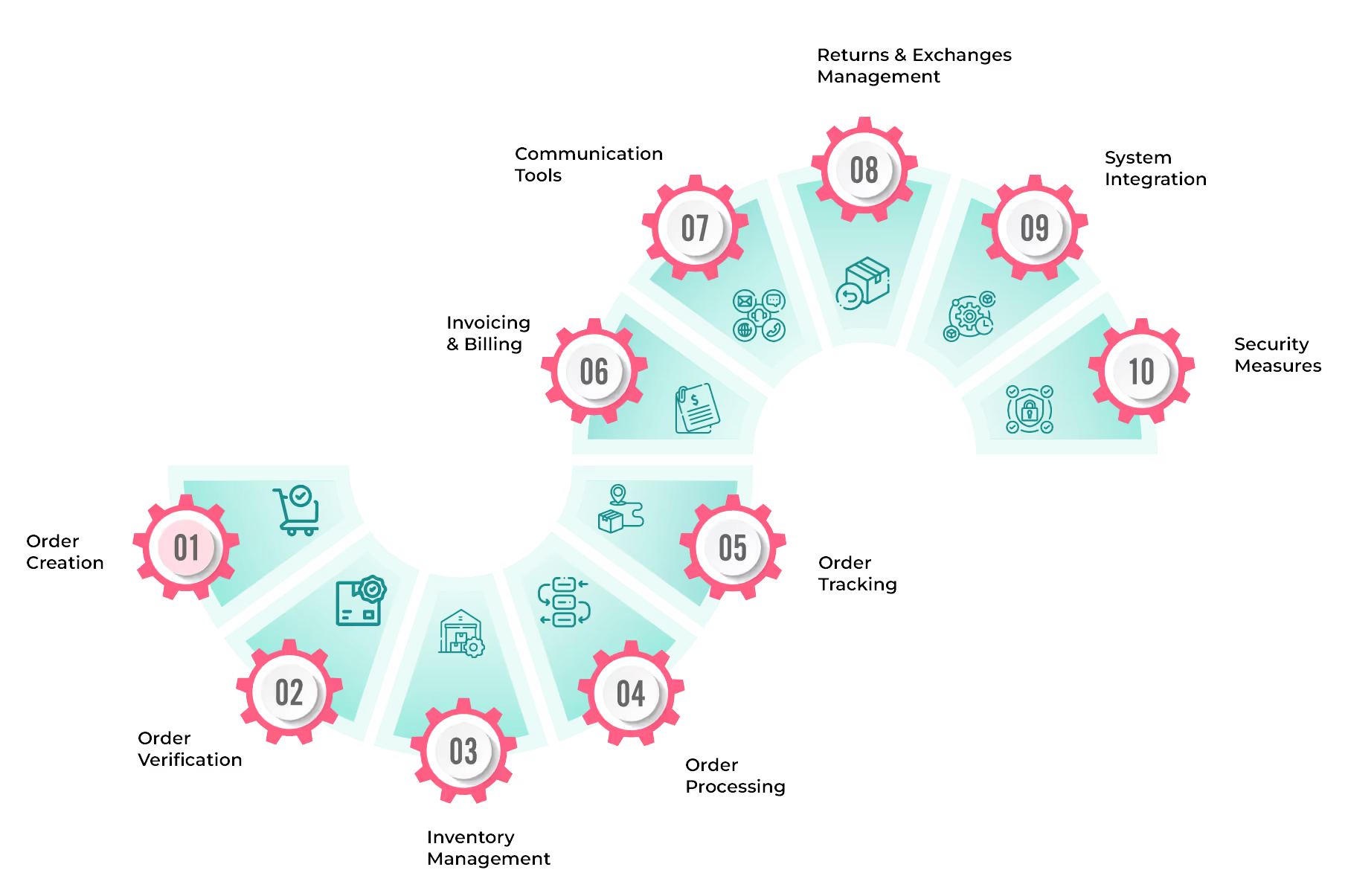
Blog
How Can You Simplify Your Sales Order Management Process?
December 11, 2023


Key Insights
When a customer places an order they expect a level of customer service. The basic expectation is to get the ordered purchase delivered timely and accurately.
But as easy as it seems, the order-to-sales purchase process is a tedious cycle for the business considering the various areas where a glitch can cause a heavy price.
To avoid such situations businesses have increasingly started to incorporate a sales order management system.
In this article, we will understand the sales order management system, its key components, the benefits of incorporating the system, and best practices that ensure its effective functioning.
So scroll down for more.
What is a Sales Order Management System?
Sales Order Management refers to the process of handling and fulfilling customer orders efficiently and accurately. It is a critical component of business operations encompassing various tasks from order creation to product delivery.
An efficient Sales Order Management process is essential for providing a positive customer experience, reducing errors, and optimizing operational efficiency. It streamlines the sales management process, minimizes errors, and enhances customer satisfaction.
a sales order management system involves collaboration across multiple departments, including sales, operations, inventory management, and finance, to ensure the seamless fulfillment of customer orders.
Key Components of Effective Sales Order Management
Effective Sales Order Management involves the coordination of various components to ensure smooth and accurate processing of customer orders.
Let's look at the key components of an effective Sales Order Management system:

- Order Creation
An efficient sales order management system for creating sales orders with the ability to capture essential information such as customer details, product specifications, quantities, and pricing.
- Order Verification
Sales order management processes must have mechanisms to verify the accuracy and completeness of sales orders, including checks for product availability, pricing consistency, and validation against customer records.
- Inventory Management
Sales and order management must integrate with inventory systems to monitor stock levels, prevent over-selling, and optimize inventory turnover thereby ensuring that products are available for fulfillment.
- Order Processing
Clearly defined and automated workflows facilitate the coordination of various departments involved in order processing, including sales, warehouse supplies, shipping, and finance.
- Order Tracking
Sales order management systems must have provision for customers to track their orders in real-time, providing visibility into the status of their purchases from order creation to delivery.
- Invoicing and Billing
An ideal sales order management example will have an automated generation of accurate invoices with details such as product costs, taxes, and shipping charges. It must be able to handle billing processes seamlessly.

- Communication Tools
Sales order management must-have communication tools to keep customers informed at various stages, including order confirmation, shipping notifications, and resolution of inquiries or concerns.
- Returns and Exchanges Management
It must incorporate processes and workflows for handling returns and exchanges, including issuing return authorizations, processing returned items, and managing refunds or replacements.
- System Integration
Sales order management systems must be seamlessly integrated with other business systems, such as Customer Relationship Management and Enterprise Resource Planning to ensure data consistency across the organization.
- Security Measures
While incorporating sales order management systems organizations must ensure robust security measures to protect sensitive customer and order data and adhere to data protection regulations to safeguard against unauthorized access.
An effective Sales Order Management system optimizes operational efficiency, reduces errors, enhances customer satisfaction, and provides valuable insights for strategic decision-making.
Benefits of Sales Order Management System?
A Sales Order Management System offers numerous benefits for businesses involved in the sales process. Let's take a look at it.

Efficiency and Automation
Sales order management system streamlines the entire sales order process, reducing manual effort and minimizing errors. Automation of routine tasks such as order creation, validation, and processing saves time and resources thereby ensuring efficiency.
Order Accuracy
Incorporating a sales order management system helps ensure accuracy by validating order details against available inventory and pricing information. It reduces the risk of errors in order entry and enhances customer satisfaction.
Improved Customer Service
An efficient sales order management system provides real-time order tracking and status updates that allow businesses to respond promptly to customer inquiries. These practices enhance the overall customer experience through better communication and reliability.
Additionally, evaluating sales team structure ensures that the right personnel are strategically placed, fostering effective communication channels and maximizing the system's potential to meet customer needs efficiently.
Inventory Management
Integrating your sales order management system with inventory systems helps manage stock levels, prevents over-selling, and reduces the likelihood of stockouts. It helps optimize inventory turnover and contributes to better demand planning.
Enhanced Visibility
The greatest perk of incorporating a sales order management system is that it offers a centralized platform for monitoring the entire order-to-cash cycle, providing visibility into order status and historical data. It enables better decision-making through access to comprehensive sales and order information.
Streamlined Financial Processes
The system facilitates billing and invoicing processes, ensuring accurate and timely generation of invoices thereby supporting financial reconciliation and integration with accounting systems. Additionally, incorporating specialized accounting software can further streamline and enhance the overall financial management, providing a comprehensive solution for businesses to manage their billing, invoicing, and accounting seamlessly.
Easy Scalability
Sales order management systems can adapt to the changing needs of the business as it grows and provide scalability to handle an increasing volume of sales orders. This supports business expansion by accommodating diverse sales channels and markets.
Regulatory Compliance
Sales order management system facilitates the generation of necessary documentation and helps businesses adhere to regulatory requirements by ensuring that orders comply with industry standards and guidelines.
Data Analysis and Reporting
It provides reporting and analytics tools for analyzing sales data, tracking performance metrics, and identifying trends thereby enhancing data-driven decision-making and strategic planning. Additionally, by incorporating sales productivity metrics, organizations can efficiently measure and optimize the effectiveness of their sales processes, ultimately driving greater efficiency and informed decision-making in sales strategies.
Implementing a Sales Order Management System contributes to operational efficiency, customer satisfaction, and overall business success by optimizing the sales order process and facilitating better management of resources and information.
Common Challenges in Sales Order Management:
Even with the best systems in place, businesses can encounter several challenges in sales order management. Recognizing these obstacles is the first step toward finding effective solutions.
- Manual data entry errors: Relying on manual data entry can lead to inaccuracies in order details, customer information, and inventory levels. These errors can result in incorrect orders, delayed shipments, and dissatisfied customers.
- Poor communication between departments: Lack of communication between sales, inventory, and fulfillment departments can cause delays and errors in order processing. Miscommunication can lead to incorrect inventory updates, missed deadlines, and customer service issues.
- Inventory inaccuracies: Discrepancies between physical inventory and recorded inventory can lead to order fulfillment problems. If the system shows items in stock when they are not, or vice versa, it can cause delays and customer dissatisfaction.
- Delays in order processing and fulfillment: Inefficient order processing workflows and bottlenecks in fulfillment can lead to delays in shipping and delivery. These delays can frustrate customers and damage the company's reputation. This can occur due to lack of automation, or proper software.
Addressing these challenges requires a combination of technology, process improvements, and effective communication strategies.
By implementing a robust sales order management system and adhering to best practices, businesses can streamline their operations and enhance customer satisfaction.
Best Practices for Maintaining Sales Order Management
An effective Sales Order Management System ensures smooth operations and positive customer experience. So let's look at some best practices that yield these results. Additionally, incorporating robust sales territory management practices further enhances efficiency by strategically assigning and organizing sales activities, optimizing resource allocation, and fostering stronger customer relationships within specific geographical areas.
- Regular system audits will help identify and rectify any discrepancies, errors, or outdated information. This includes reviewing order records, customer data, and inventory levels.
- Regularly review and update customer data, product information, and pricing details to ensure accuracy and correct data inconsistencies.
- Update access controls and permissions and stay current with security updates for the sales and order management system to protect against potential vulnerabilities.
- Ensure continued seamless integration with other business systems, such as CRM, ERP, and inventory management.
- Regularly evaluate the system's scalability to ensure it can accommodate the growing volume of sales orders as the business expands.
- Regularly test data backup and disaster recovery procedures to safeguard against data loss or system failures. Ensure quick recovery in case of unexpected events.
- Regularly update and optimize customer communication tools including order confirmations, shipping notifications, and customer support channels.
- Periodically optimize order processing workflows to identify bottlenecks, streamline processes, and improve overall efficiency.
- Establish mechanisms for gathering feedback from users and stakeholders to identify areas for improvement and implement enhancements accordingly.
Incorporating these best practices into the Sales Order Management system maintenance helps businesses to ensure efficiency, accuracy, and alignment with their operational requirements over time.
Concluding Thoughts
Having an organized approach to business makes it easy to monitor, track, and streamline operations. With a sales order organization system, this is what organizations achieve while handling their order-to-sales cycle.
From receiving an order to finally delivering the purchase, the organization must be vigilant to ensure there is no gap in communication or compromise on customer satisfaction.
Taking a step-by-step approach where no stone remains unturned including verifying orders, managing inventory, tracking orders, billing accurately, and even taking measures to keep the customer data is crucial in efficiently managing your sales order system.
With automation in the sales order management process, a lot of the everyday routine and tedious tasks have been made easy and efficient. The tool ensures streamlined order management with zero error chances.
Incorporating automation solutions has proved time and again to enhance sales operations. From easing the incentive calculation to effective sales performance tracking, it has touched all realms of sales management.
Moreover, evaluating sales performance through comprehensive analytics and key performance indicators allows businesses to make data-driven decisions, identify areas for improvement, and strategically refine their sales strategies for sustainable growth.
Kennect builds, runs, and automates your incentive compensation plans to create transparency and achieve operational efficiency. For more information, Book A Demo NOW!
ReKennect : Stay ahead of the curve!
Subscribe to our bi-weekly newsletter packed with latest trends and insights on incentives.
Thank you! Your submission has been received!
Oops! Something went wrong while submitting the form.
Your data is in safe hands. Check out our Privacy policy for more info















